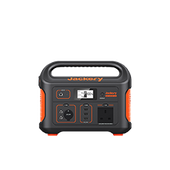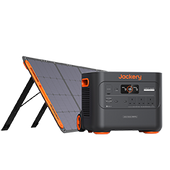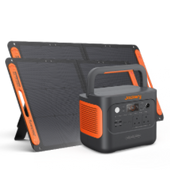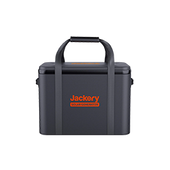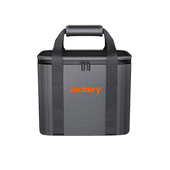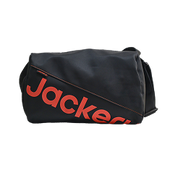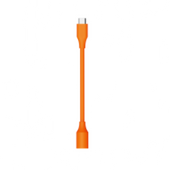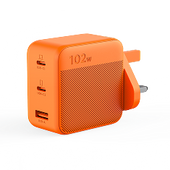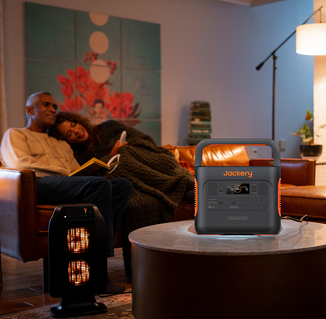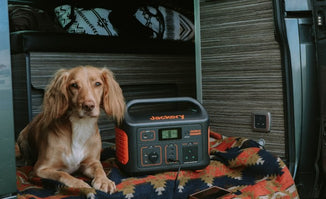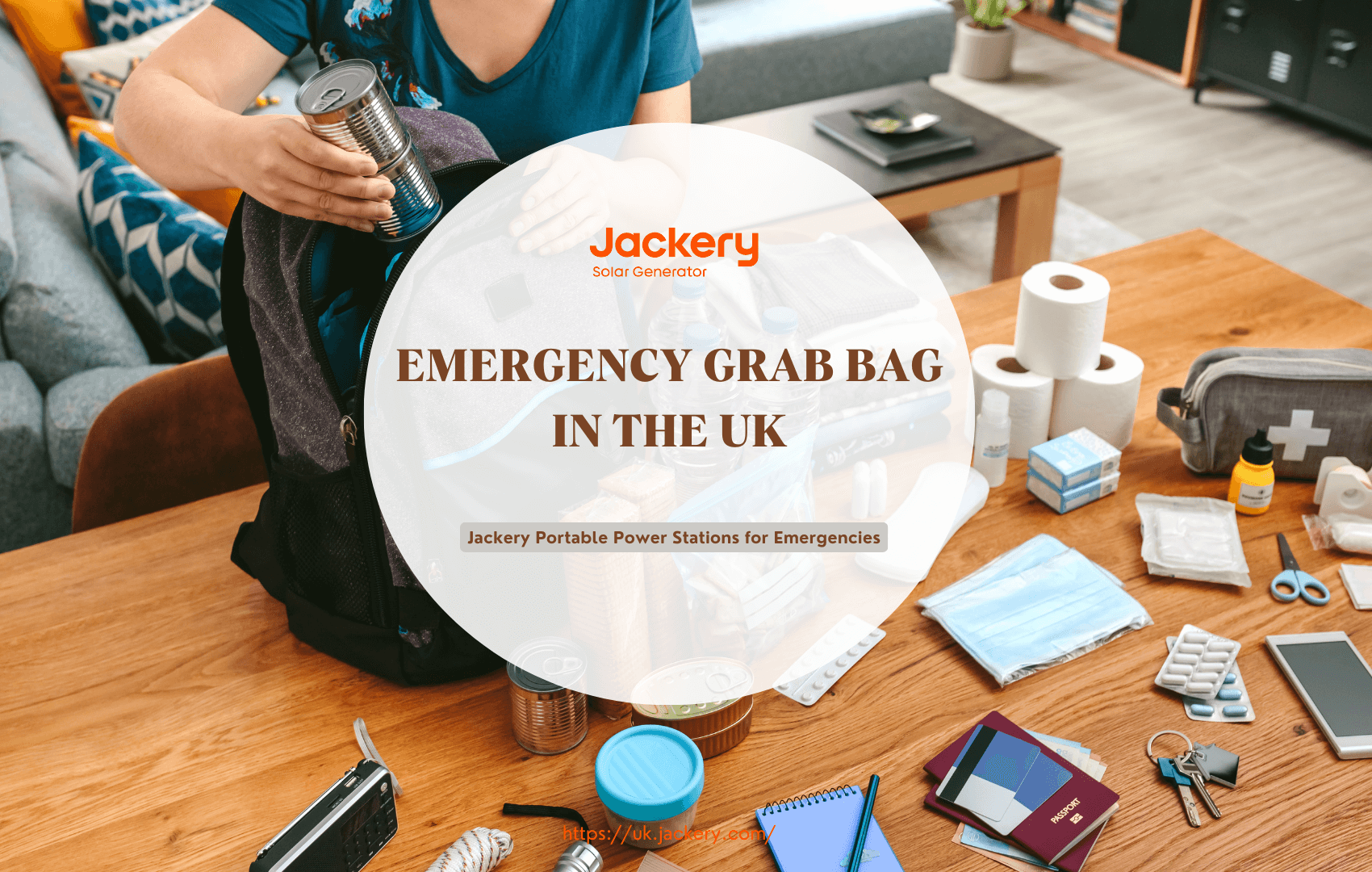How would you handle an emergency in an unpredictable, constantly changing environment where power outages, natural disasters, chemical risks, war, and other calamities can happen at any time?
Having an emergency grab bag on hand, commonly called a "go bag or grab bag," is a wise precaution that, ideally, will never be necessary. It's a crucial part of personal preparedness that the government now advises everyone to consider having. Continue reading to learn the contents of an emergency bag and why you should have one.
Besides, we highly recommend Jackery Portable Power Station, a portable power solution to charge your appliances during an emergency, such as your phone, radio, refrigerator, flashlight, etc.
|
Key Takeaways: |
|
Emergency grab bags are already filled with items you can take with you in case of an emergency evacuation. That could result from a significant flood, fire, tsunami, volcanic eruption, strong earthquake, or severe storm. When you are prepared with an emergency bag, you may leave swiftly and with the necessities, which lessens anxiety and uncertainty in stressful situations. You should include water, food, masks, light, clothes, first aid, communication devices, documents, and extras in your emergency grab bag. We recommend putting Jackery Explorer 240 v2 or 300 Plus in your bag to ensure a consistent power supply. Understand the necessity of regularly checking and updating emergency grab bags. |
What Is An Emergency Grab Bag?
Emergency grab bags are already filled with items you can take with you in case of an emergency evacuation. That could result from a significant flood, fire, tsunami, volcanic eruption, strong earthquake, or severe storm.
The necessities for up to three days away from home should fit in grab bags. Specific necessities, such as a bed, water, and an evacuation shelter or community emergency hub, may be supplied if one is nearby. However, you'll have to bring a few items and take care of everything while travelling there - it might be a pleasant stroll.
Having a grab bag is a proactive step that anybody can take to ensure they have the materials they need to deal with the immediate aftermath of an emergency scenario. It's especially crucial if you have to travel a long distance to get home during an emergency.
Why Is An Emergency Grab Bag Important?
Being ready for unforeseen emergencies is the primary justification for owning an emergency kit. Emergencies can strike any time and cause havoc in our daily lives, whether artificial or natural disasters like fires, floods or hazardous substance spills. When you are prepared with an emergency bag, you may leave swiftly and with the necessities, which lessens anxiety and uncertainty in stressful situations.
Download The Emergency Grab Bag PDF Checklist >>
What Should You Include in An Emergency Grab Bag?
When assembling your emergency grab bag, consider the unique requirements of your families, such as the elderly, young children, or individuals with impairments, and prepare your belongings appropriately. Remember any food limitations or dietary sensitivities.
After assembling your emergency kit, make sure everyone in the household knows where it is kept and keep it in a dedicated location. If you have to leave your house quickly, it should be simple to get to even during a power outage (you should not bring anything with you if you are fleeing a fire).
If you have one, think about packing a smaller emergency bag in your car, complete with a tiny shovel and hi-vis clothes. It is advisable to create a home emergency plan document that includes vital information such as contact data for utility companies, medical conditions and prescriptions, insurance information, and household members in case of an emergency.
You, your family, and your roommates must prepare to care for yourself in an emergency. Assembling an emergency kit is one method of being ready. Here are a few things and information you may want to put in your emergency grab bag. This must be stored in a home accessible to all members in an emergency.

Water: Everyone should bring at least 1.5 litres of drinking water daily. Mineral water bottles are easy to travel but have a short shelf life, so you'll need to swap them out frequently. Emergency drinking water pouches, also utilised in life-raft supplies, are a sophisticated addition to your emergency pack, as they have a five-year shelf life. Including water purification tablets in your bag can help you carry less water since they can treat practically any type of water and make it safe to drink. You can use a purification or filter bottle to purify your water instead of using chemicals. These are tiny bottles that have built-in filter cartridges.
Food: To stay self-sufficient in the early aftermath of an incident, include ready-to-eat food in your bag. When used in life rafts, emergency food rations offer a high-calorie, long-lasting cookie that is convenient to store and compact. Armies worldwide use ration packs, which are a great option. Additionally, or as a temporary substitute, include trail mix or snack bars; remember to swap them out regularly.
Masks: People can go for days without food or drink, but they can only last for a few minutes without air. At the scene of an accident or disaster, there is frequently an abundance of dust and debris. You can filter dust, particles, and aqueous mists by covering your mouth and nose with a disposable respirator mask.
Fold-flat masks are perfect for emergencies because they are portable and small. The nominal filtration efficiency of FFP2 masks is 95%, while that of FFP3 masks is equivalent to N99, 99%, and N95, respectively. Healthcare professionals typically wear FFP3 respirator masks to protect themselves from airborne pathogens.
Light: A reliable torch is a must-have for your emergency grab bag. Opt for an LED emergency torch instead of a conventional one, as the former may operate for thousands of hours without requiring additional bulbs.
Investing in a variety of torch kinds makes sense. Wearing a headlamp on your forehead will free up your hands for other duties. Get two different types of handheld flashlights as well. Select a wind-up torch with an integrated dynamo that charges its internal batteries to ensure you never run out of power.
Secondly, use a torch on batteries for convenience and an intense beam. Whichever spare batteries you need, lithium batteries will continue to function correctly even after being stored for more than ten years, whilst alkaline batteries typically have a five-year shelf life. Getting some lightsticks of military grade is another excellent suggestion. These can be used as position markers and emergency lights.
Clothes: Staying dry and warm is crucial. Choose lightweight and small-sized goods for your bag because there is little room. Clothes in layers offer greater versatility. Travelling ponchos are an intelligent option for staying dry.
Although they work well at trapping body heat, foil blankets are only helpful when the wearer rests. An emergency foil poncho is an excellent option since it is lightweight and portable, keeping you dry and warm even when you move around. For a nighttime shelter, bring along a small survival sleeping bag as well.
First Aid: Your first aid kit should contain items appropriate for your level of training and experience. It should contain supplies for cleaning and dressing wounds, eyewash, and burn bandages. You should also include a week's worth of personal prescription products and essential drugs.
Communication: In an emergency, phone and mobile networks - may stop working or become overloaded locally. Licence-free walkie-talkie radios are a great option to chat with someone who lives a few kilometres away from you because they don't rely on networks to function. A satellite phone can be your sole dependable email and voice communication option for extended distances because it doesn't depend on local networks.
Information is vital in any crisis. Use a portable AM/FM radio receiver to tune in to emergency radio broadcasts. Emergency radios, which have built-in generators for wind-up power, can be used at any time, just like your torches. It is essential to remember that you cannot access mains energy or the Internet.
Power Supply: Bring extra spare batteries for different tools and an emergency mobile phone charger to connect when service is restored. Select lithium batteries with a long lifespan because they are low in weight and suitable for usage in harsh environments. We also strongly advise adding a personal flashing beacon for rescue, waterproof tape, a loud whistle, and a high-quality multi-tool to your bag.
During emergencies, electricity is a lifeline. It provides power to critical devices and systems that can substantially impact individuals' overall well-being, comfort, and safety. It facilitates evacuation, search, and rescue operations by illuminating gloomy areas. Charges phones and other devices to enable communication with emergency authorities and families. Therefore, it is essential to have an emergency generator, like Jackery Portable Power Station, to charge them all.

Documents: Bring copies of your driver's license and other identification documents, area maps, keys, prescription drugs, cash, and any vital contact information you might need in case you have to flee your house. Place these things in a map case or waterproof document pouch. Pack pencils, self-adhesive labels, or waterproof notepaper and tape to leave notes and directions for others to follow.
The Bag: Get a medium-sized backpack with enough room for everything you need for survival. Although the bag doesn't have to be waterproof, you can line your backpack with a thin, dry sack to preserve your equipment. Applying photoluminescent tape or fastening a reflective and photoluminescent safety armband to the handle of your bag can help it stand out in the dark.
Jackery Portable Power Stations for Emergencies
In emergencies, electricity serves as a vital resource. It supplies energy to essential equipment and systems that significantly affect the overall welfare, comfort, and safety of persons. It enhances evacuation, search, and rescue efforts by illuminating dark locations.
It manages critical medical machines, such as insulin pumps, CPAP machines, etc. It charges mobile phones and other devices to enable communication with emergency authorities.

Jackery is the leading brand for portable power supply, especially solar-powered products. Jackery Portable Power Station is a portable powerhouse that provides enough electricity during emergencies. Jackery Solar Panels, wall outlets, and carports can recharge it. Here, we recommend Jackery Explorer 240 v2 and 300 Plus portable power stations.
Jackery Explorer 300 Plus
The Jackery Explorer 300 Plus portable power station is a lightweight and efficient power source that fulfils energy requirements for diverse scenarios with 288Wh capacity, including blackouts, power outages, camping emergencies, and more.

- Multiple Outputs to Charge Devices: The Explorer 300 Plus is a portable power station featuring a 300WAC Pure Sine Wave Inverter (600W Surge Peak) and a capacity 288Wh. This device can charge four devices simultaneously with its 1 AC, 1 USB-A, and 1 USB-C output, making it quick and easy to charge multiple appliances.
- Superior Safety Technology: This power station features a distinctive Battery Management System (BMS). The gadget incorporates 52safety measures and 12 BMS algorithms that collaboratively provide the utmost safety for both the device and any connected appliances. It includes four types of physical security to guarantee the safety of all individuals.
- Compact and Innovative Power Supply: This model is distinguished by its sophisticated app control feature, enabling users to manage the battery efficiently via WiFi or Bluetooth. This renders it more contemporary and user-friendly. Weighing merely 27 pounds, it is an exceptional option for individuals frequently in outdoor adventures or extreme weather conditions.
|
*Review from Our User |
|
I'm planning a car camping trip with my family this summer, and I need a way to connect my CPAP. After checking out other reviews, I purchased a car A/C adapter and connected my CPAP to this Jackery. Without the humidifier and heated tube, it hardly consumed 10% of the battery over 8 hours! |
Jackery Explorer 240 v2
Constructed with a robust LiFePO4 battery, offering a lifespan of 10 years, the Explorer 240 v2 guarantees dependable operation after 3,000 charge cycles. This compact powerhouse has 256Wh of energy and weighs only 7.7 lbs, ensuring you remain charged while on the go. With a robust 300W AC output, charging vital gadgets is now effortless.

- One-Hour Fast Charging: Efficient, one-hour rapid charging, initiated by an application, enables a complete charge of the Explorer 240 v2 Portable Power Station within one hour. Recharging from 0% to 100% requires about twohours using an AC wall outlet, promoting a healthy battery lifespan, but a complete charge via SolarSaga 100W solar panels necessitates 3 hours.
- Multiple Charging Ports: The Explorer 240 v2 features 100W PD USB-C ports, enabling direct USB-C fast charging for various electrical devices without needing an additional power brick. Numerous charging connections provide the concurrent charging of multiple devices, while an integrated camping light serves as both an outdoor companion and an emergency illumination solution.
- SMART App Control: The highly customisable Explorer 240 v2 is designed to fulfil unique requirements, featuring changeable elements such as automatic shut-off and battery conservation mode, ensuring a tailored experience. The intelligent application facilitates the monitoring of your device's status, including the remaining battery level, over WiFi or Bluetooth connectivity.
|
*Review from Our User |
|
I placed my order right before the hurricane, but thankfully, it wasn't necessary. It charged up flawlessly. The application functioned as expected. The connection to the WiFi system was established. The interface provides a wealth of information. It features a convenient LED light. I decided to test it by placing my large desktop on it, which worked exceptionally well. |
Tips for Preparing for Your Emergency Grab Bag
Here, we provide you with many tips on preparing grab bags; we believe that it can provide you with more comprehensive ideas, so let's take a look together:
- Select a bag for your equipment. You can carry them with ease, freeing up your hands.
- Go more considerable than you think you'll need to ensure you have enough space to search for items without unpacking the entire suitcase. Several distinct sections will help you arrange the equipment.
- Ensure that each family member has a grab bag. You will need items that are particular to you both, and you may need to evacuate at different times if one of you has a long commute home from work.
- It's easier to carry two tiny water bottles and one huge one. When stored commercially, bottled water frequently lasts for two years. Carrying nine litres of water for three days is impractical, but smaller bottles can be filled as needed.
- To prevent the growth of bacteria, ensure the used water bottles are clean and haven't held milk or other dairy products before filling them. To keep air out, fill them to the top. When stored properly, chlorinated tap water should last a year.
- To keep Chlorinated water safe to drink, add water purification pills or drops (as instructed on the carton). Be cautious when using household bleach products, as some contain scents and detergents that aren't listed in the ingredients and shouldn't be used with drinking water.
- Select a radio and torch that runs on batteries. They outperform wind-up models by a wide margin. NiMH batteries in wind-up devices frequently stop functioning correctly after extended storage without frequent use or charging.
- Select masks with a P2 or N95 rating. They filter out more particles than P1 masks and provide superior protection against some viruses and harmful dust and ash (such as those that arise after an earthquake or volcanic eruption).
- Not every first aid kit sold in stores is good. If you're purchasing a pre-made one, ensure it includes other necessities and a wide variety of wound dressings, including large ones. Large kits often contain tiny plasters and thin bandages that are ineffective for treating more extensive wounds.
- Select merino, wool, polyester, or polypropylene items for warm apparel. Cotton jeans, hoodies, and T-shirts will keep you cool if they become wet from sweat.
- Keep your grab bags in a convenient location so you can get out quickly. For instance, if you have to stay overnight - during a significant earthquake - think about storing a kit at work, along with a blanket. Keeping additional water in your work equipment (nine litres or more) is also a good idea.
- Update your plans and emergency supplies, and grab bags every year. Food, drink, batteries, and some first aid supplies run out. In addition, additional supplies will be required if your household grows or any family members' needs alter. If you relocate, your emergency plan might also need to be updated.
Download Emergency & Evacuation Plan PDF >>
Regularly Review & Update Your Emergency Grab Bag
An emergency grab bag is more than simply a gathering of supplies; it's a lifesaver in an unplanned circumstance. Knowing you are ready to look after yourself and your loved ones gives you peace of mind. Spend time creating and maintaining your emergency kit; it might save your life when it matters most. Additionally, you don't have to buy everything at once; instead, you can gradually assemble your emergency supply bag by adding to it as you can.
While there is no legal obligation regarding the review period, it is crucial to review and update your grab bag periodically. This ensures that all items are in good condition, functional (e.g., batteries and electronics), and up to date.
Rotating food and water supplies, updating contact information, and considering seasonal adjustments based on location are essential. This demonstrates your commitment towards health and safety preparedness.
Inspect the bag every six months, replace expired supplies (ensure the first aid kit's expiration date is met), charge any rechargeable batteries, and update the kit based on your family's changing needs.
Emergency Grab Bag in The UK FAQs
The following are the frequently asked questions about the emergency grab bag in the UK:
- Should every family member have an emergency grab bag?
It's ideal for each family member to have a small grab bag with personal essentials, especially if you have specific needs (e.g., medication, baby supplies). However, a giant family bag can also be packed with shared items like food and water.
- What documents should I keep in my emergency grab bag?
You should include copies of important documents such as:
- Identification (passport, driver's license)
- Insurance policies
- Emergency contact information
- Any medical records or prescriptions
- How much food and water should be in my emergency grab bag?
Pack enough non-perishable food and water for at least 72 hours (three days). Aim for at least 2 litres of water per person daily, and consider high-energy snacks like nuts or protein bars.
- What kind of clothing should be packed in an emergency grab bag?
Pack warm, durable clothing suitable for the season. Include a weatherproof jacket, hat, gloves, and sturdy shoes. A blanket or emergency thermal blanket is also a good idea.
- Should I include money in my emergency grab bag?
Carrying small amounts of cash is a good idea since card payment systems and ATMs might not be accessible in an emergency. With the supplies required for survival and safety, this list might assist you in being ready for unforeseen circumstances.
Final Thoughts
You and your family must prepare for evacuation in case of hurricanes, rising floods, wildfires, or a massive earthquake. Possibly the most crucial item to pack is an "emergency grab bag" that contains necessary supplies in case of disaster. Go bags are available to help you avoid having to run about trying to gather stuff in case of an impending threat. These bags are made to give you everything you need to survive a few days following a disaster, mainly if reliable services are unavailable.









